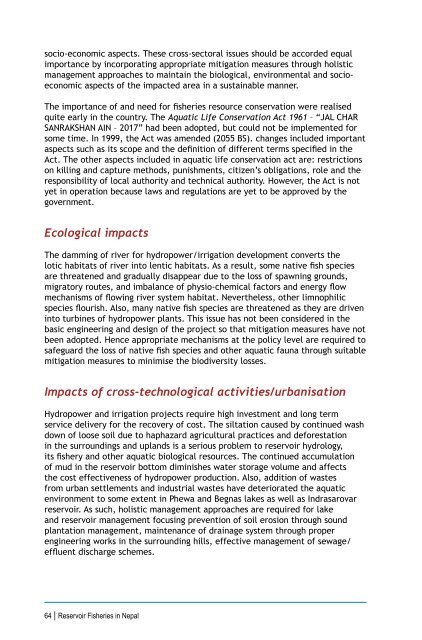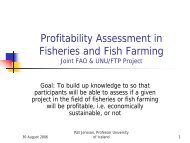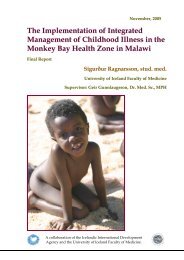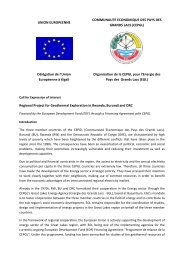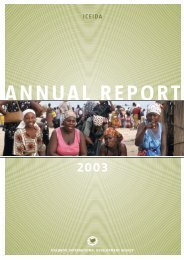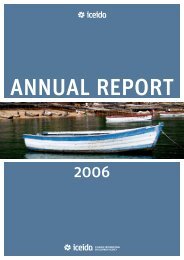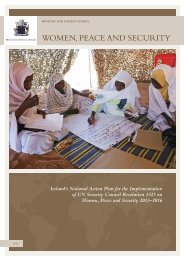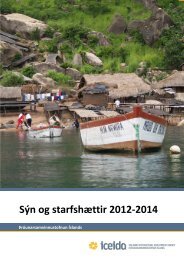Reservoir Fisheries of Asia
Reservoir Fisheries of Asia
Reservoir Fisheries of Asia
You also want an ePaper? Increase the reach of your titles
YUMPU automatically turns print PDFs into web optimized ePapers that Google loves.
socio-economic aspects. These cross-sectoral issues should be accorded equal<br />
importance by incorporating appropriate mitigation measures through holistic<br />
management approaches to maintain the biological, environmental and socioeconomic<br />
aspects <strong>of</strong> the impacted area in a sustainable manner.<br />
The importance <strong>of</strong> and need for fisheries resource conservation were realised<br />
quite early in the country. The Aquatic Life Conservation Act 1961 – “JAL CHAR<br />
SANRAKSHAN AIN – 2017” had been adopted, but could not be implemented for<br />
some time. In 1999, the Act was amended (2055 BS). changes included important<br />
aspects such as its scope and the definition <strong>of</strong> different terms specified in the<br />
Act. The other aspects included in aquatic life conservation act are: restrictions<br />
on killing and capture methods, punishments, citizen’s obligations, role and the<br />
responsibility <strong>of</strong> local authority and technical authority. However, the Act is not<br />
yet in operation because laws and regulations are yet to be approved by the<br />
government.<br />
Ecological impacts<br />
The damming <strong>of</strong> river for hydropower/irrigation development converts the<br />
lotic habitats <strong>of</strong> river into lentic habitats. As a result, some native fish species<br />
are threatened and gradually disappear due to the loss <strong>of</strong> spawning grounds,<br />
migratory routes, and imbalance <strong>of</strong> physio-chemical factors and energy flow<br />
mechanisms <strong>of</strong> flowing river system habitat. Nevertheless, other limnophilic<br />
species flourish. Also, many native fish species are threatened as they are driven<br />
into turbines <strong>of</strong> hydropower plants. This issue has not been considered in the<br />
basic engineering and design <strong>of</strong> the project so that mitigation measures have not<br />
been adopted. Hence appropriate mechanisms at the policy level are required to<br />
safeguard the loss <strong>of</strong> native fish species and other aquatic fauna through suitable<br />
mitigation measures to minimise the biodiversity losses.<br />
Impacts <strong>of</strong> cross-technological activities/urbanisation<br />
Hydropower and irrigation projects require high investment and long term<br />
service delivery for the recovery <strong>of</strong> cost. The siltation caused by continued wash<br />
down <strong>of</strong> loose soil due to haphazard agricultural practices and deforestation<br />
in the surroundings and uplands is a serious problem to reservoir hydrology,<br />
its fishery and other aquatic biological resources. The continued accumulation<br />
<strong>of</strong> mud in the reservoir bottom diminishes water storage volume and affects<br />
the cost effectiveness <strong>of</strong> hydropower production. Also, addition <strong>of</strong> wastes<br />
from urban settlements and industrial wastes have deteriorated the aquatic<br />
environment to some extent in Phewa and Begnas lakes as well as Indrasarovar<br />
reservoir. As such, holistic management approaches are required for lake<br />
and reservoir management focusing prevention <strong>of</strong> soil erosion through sound<br />
plantation management, maintenance <strong>of</strong> drainage system through proper<br />
engineering works in the surrounding hills, effective management <strong>of</strong> sewage/<br />
effluent discharge schemes.<br />
64 | <strong>Reservoir</strong> <strong>Fisheries</strong> in Nepal


